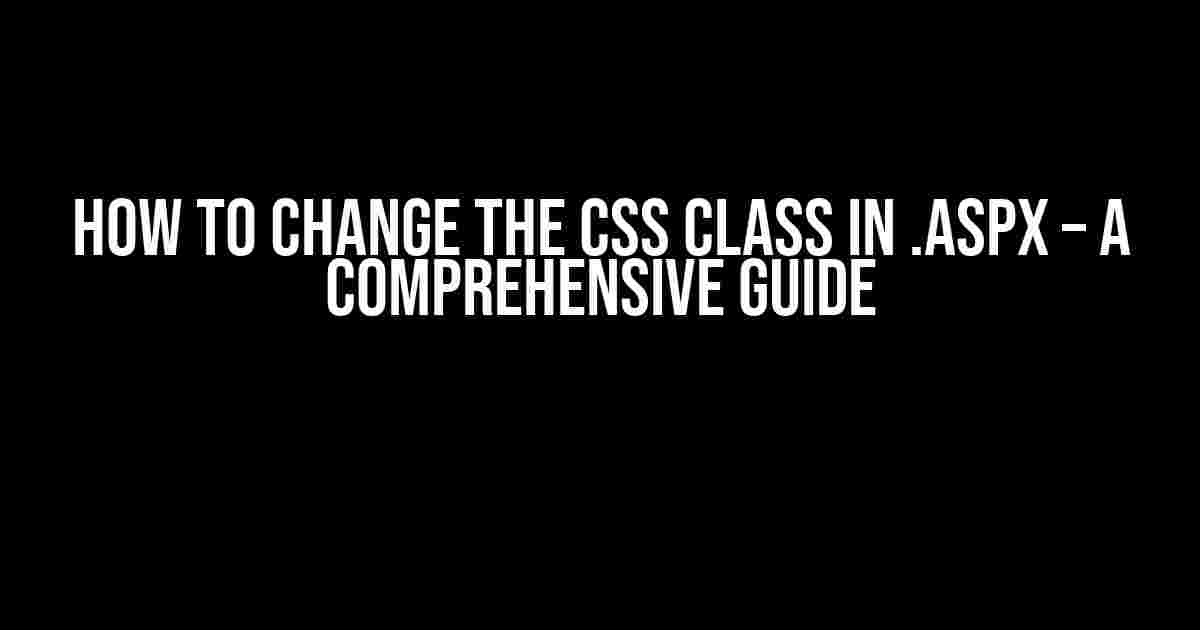Are you tired of being stuck with the same old CSS classes in your .aspx files? Do you want to learn how to dynamically change the CSS class in .aspx and take your web development skills to the next level? Look no further! In this article, we’ll dive into the world of .aspx and CSS, and explore the different ways to change the CSS class in .aspx. So, buckle up and let’s get started!
Why Change the CSS Class in .aspx?
Before we dive into the how-to, let’s take a step back and understand why changing the CSS class in .aspx is important. There are several reasons why you might want to change the CSS class in .aspx, including:
- Dynamic Styling**: You want to dynamically change the styling of your web page based on user interactions, such as hover effects, click events, or scrolling.
- Conditional Styling**: You want to apply different styles based on certain conditions, such as the user’s location, browser type, or screen size.
- Improved User Experience**: You want to provide a better user experience by adapting your website’s layout and design to different devices and screen sizes.
Methods to Change the CSS Class in .aspx
Now that we’ve covered the why, let’s explore the different methods to change the CSS class in .aspx. We’ll cover both server-side and client-side approaches, so you can choose the one that best suits your needs.
Server-Side Approach: Using ASP.NET Web Forms
In ASP.NET Web Forms, you can change the CSS class in .aspx using the following methods:
- Using the `CssClass` Property**:
- Using the `Attributes` Property**:
- Using a Custom Control**:
<asp:Label ID="myLabel" runat="server" CssClass="old-class" />You can change the CSS class by assigning a new value to the `CssClass` property in the code-behind file:
myLabel.CssClass = "new-class";<asp:Label ID="myLabel" runat="server" />You can add or remove CSS classes using the `Attributes` property in the code-behind file:
myLabel.Attributes.Add("class", "new-class");
myLabel.Attributes.Remove("class", "old-class");You can create a custom ASP.NET Web Forms control that allows you to change the CSS class dynamically:
public class MyLabel : Label
{
public string DynamicCssClass { get; set; }
protected override void Render(HtmlTextWriter writer)
{
writer.AddAttribute(HtmlTextWriterAttribute.Class, DynamicCssClass);
base.Render(writer);
}
}You can then use the custom control in your .aspx file:
<asp:MyLabel ID="myLabel" runat="server" DynamicCssClass="new-class" />Client-Side Approach: Using JavaScript and jQuery
On the client-side, you can change the CSS class in .aspx using JavaScript and jQuery. Here are a few examples:
- Using JavaScript**:
- Using jQuery**:
- Using jQuery with a CSS Selector**:
<script type="text/javascript">
var element = document.getElementById("myElement");
element.className = "new-class";
</script><script type="text/javascript">
$("#myElement").addClass("new-class");
$("#myElement").removeClass("old-class");
</script><script type="text/javascript">
$("div.myClass").addClass("new-class");
$("div.myClass").removeClass("old-class");
</script>Best Practices and Considerations
When changing the CSS class in .aspx, it’s essential to keep in mind the following best practices and considerations:
- Separation of Concerns**: Keep your CSS, HTML, and JavaScript code separate and organized to maintain a clean and maintainable codebase.
- Performance**: Avoid excessive DOM manipulation, as it can impact performance. Use JavaScript and jQuery efficiently to minimize page reloads and improve user experience.
- Cross-Browser Compatibility**: Ensure that your CSS and JavaScript code is compatible with different browsers and versions to avoid rendering issues.
- Accessibility**: Follow accessibility guidelines to ensure that your website is usable by everyone, regardless of their abilities.
Conclusion
Changing the CSS class in .aspx can be a powerful tool in your web development arsenal. By understanding the different methods and approaches, you can create dynamic, responsive, and interactive web applications that provide an exceptional user experience. Remember to follow best practices and consider the implications of your code on performance, accessibility, and cross-browser compatibility. Happy coding!
| Method | Server-Side | Client-Side |
|---|---|---|
| CssClass Property | Yes | No |
| Attributes Property | Yes | No |
| Custom Control | Yes | No |
| JavaScript | No | Yes |
| jQuery | No | Yes |
By now, you should have a comprehensive understanding of how to change the CSS class in .aspx. Remember to bookmark this article for future reference and share it with your fellow developers. Happy learning!
Here are 5 Questions and Answers about “How to change the css class in .aspx?” in a creative voice and tone:
Frequently Asked Question
Stuck with changing CSS classes in your ASPX file? Fear not, dear developer! We’ve got the solutions to your most pressing questions.
Q1: How do I change the CSS class of a control in ASPX?
Easy peasy! You can change the CSS class of a control in ASPX by using the CssClass property. For example, if you want to change the CSS class of a Label control, you can do it like this: `
Q2: Can I change the CSS class of a control dynamically in ASPX?
Absolutely! You can change the CSS class of a control dynamically in ASPX by using server-side code. For example, you can use the following code to change the CSS class of a Label control on a button click: `myLabel.CssClass = “new-class”;`.
Q3: How do I change the CSS class of a control in ASPX using JavaScript?
JavaScript to the rescue! You can change the CSS class of a control in ASPX using JavaScript by using the `getElementById` method to get the control and then setting its `className` property. For example: `document.getElementById(“myLabel”).className = “new-class”;`.
Q4: Can I change the CSS class of a control in ASPX using jQuery?
You bet! You can change the CSS class of a control in ASPX using jQuery by using the `addClass` or `removeClass` methods. For example: `$(“#myLabel”).addClass(“new-class”);` or `$(“#myLabel”).removeClass(“old-class”);`.
Q5: What if I want to change the CSS class of a control in ASPX based on a condition?
No problem! You can change the CSS class of a control in ASPX based on a condition by using an if-else statement in your server-side code. For example: `if (condition) { myLabel.CssClass = “new-class”; } else { myLabel.CssClass = “old-class”; }`.





